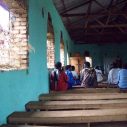
Search
Overview of a multidimensional reality of poverty in Mauritania through the MPI-M
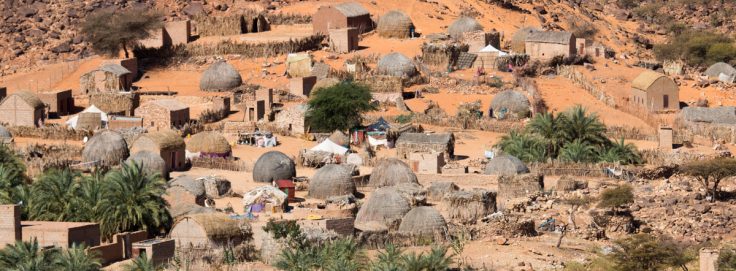
Adopting a multidimensional poverty measure
For decades, Mauritania has been committed to reducing poverty through the development of various strategic documents including the Poverty Reduction Strategy Framework (Cadre Stratégique de Lutte contre la Pauvreté, CSLP 2001-2015) and the National Strategy for Accelerated Growth and Shared Prosperity (Stratégie Nationale de Croissance Accélérée et de Prospérité Partagée, SCAPP-2016-2030).
These different strategies can only be effective if they are based on the accurate measurement of the phenomenon of poverty and the perfect targeting of policies in areas that are most affected by poverty
The Permanent Survey of Household Living Conditions (Enquête Permanente sur les Conditions de Vie des ménages – EPCV) has been carried out every four years since 1988, aiming to update and monitor indicators on household living conditions, particularly poverty.
The various poverty analyses conducted through this survey have so far focused on the evolution and profile of income poverty. In twenty years, income poverty has fallen by 22.8 percentage points, from 51% in 2000 to 28.2% in 2019.
Studies on monetary poverty are certainly necessary, but they must be complemented by multidimensional analyses, as the monetary measurement of poverty is not enough to capture the complexity and multidimensionality of human wellbeing and household living conditions.
In response to the need to understand the problem of poverty in all its forms, the National Agency for Statistics and Demographic and Economic Analysis (Agence Nationale de la Statistique et de l’Analyse Démographique et Economique, ANSADE) developed Mauritania’s first Multidimensional Poverty Index (MPI-M), which was published in March 2023.
This index, specifically designed to meet the country’s poverty reduction goals, allows for better targeting of poor populations, addresses the monitoring requirements of the Sustainable Development Goals (SDG 1.2.2), and evaluates the economic and social strategies and programmes implemented.
Constructing Mauritania’s Multidimensional Poverty Index
The process of setting up the MPI-M began with wide-ranging consultations with all the ministerial departments and the technical and financial partners, in collaboration with OPHI and UNICEF.
To ensure that the results of the MPI-M are more widely disseminated and genuinely considered in the orientation of economic and social policies, the implementation process has given priority to the involvement of the various components of the society such as the government, technical and financial partners, and civil society.
A steering committee (chaired by the Directorate General for Economic Policies of the Ministry of Economy) and a technical committee were set up to manage the entire process. These committees also ensure technical validation of the chosen methodology and the policy guidelines resulting from the analysis of the MPI-M results.
The steering and technical committees were formed by representatives from the government institutions responsible for economic policies, social policies, and programmes for the inclusion of vulnerable groups, as well as donors and technical and financial partners (UNICEF, World Bank, UNDP).
The steps followed throughout this development process of the MPI-M have allowed for the approach, the Alkire-Foster method, and the analysis of multidimensional poverty to be fully owned by an array of stakeholders in the country. This facilitated the results to be disseminated at various key political and academic events, including the African Statistics Day, the workshop for the official launch of the MPI-M which allowed the results to be disseminated to a wide audience, and an United Nations Economic and Social Commission for Western Asia (ESCWA) workshop on optimising poverty reduction policies, among others.
The MPI-M consists of four dimensions (education, health, living conditions, and employment) and 19 indicators. The choice of indicators has been guided by a thorough identification of those deprivations that figure prominently in current economic and social development programmes, and that severely hinder people’s human development and exacerbating overall vulnerability, particularly among children, youth, and women.
The poverty cut-off is equal to 38%, which means that a person is identified as multidimensionally poor if they are deprived in more than one dimension and a half.
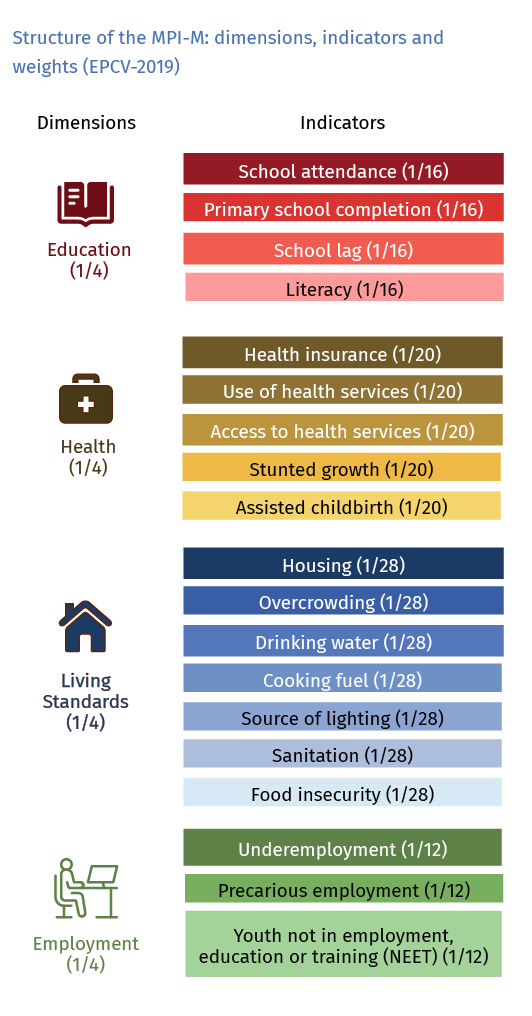
Main findings of the MPI-M
The analysis of multidimensional poverty, based on data from the EPCV (2019-2020), made it possible to provide information on the state of poverty and to outline the multidimensional profile of the poor:
- Almost six out of ten people are multidimensionally poor (56.9%), amounting to 2.3 million poor people.
- Each poor person is, on average, deprived in 56.3% of the weighted indicators.
- On average, poor people suffer almost a third of all possible deprivations (the MPI-M value is 0.320).
- Almost a quarter of the total population experience monetary and multidimensional poverty simultaneously.
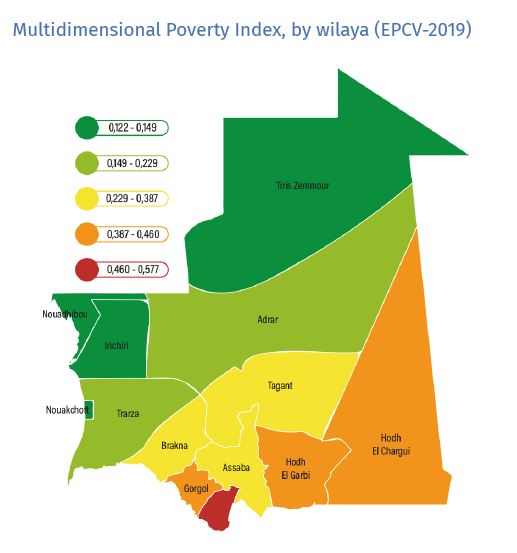
Poverty is a problem that is particularly acute in rural areas and certain regions:
- Almost seven out of ten poor people live in rural areas.
- On average, the MPI-M value is 2.5 times higher in rural areas: 0.179 in urban areas compared with 0.453 in rural areas.
- Multidimensional poverty is highly heterogeneous across wilayas. The incidence of poverty ranges from 25.2% in the wilaya of Tirs-Zemmour to 90.2% in Guidimagha.
Policies to address children’s multidimensional poverty
Mauritania’s population is young: the average age is 22 and more than half of the population (50.7%) are under 18.
The design of the MPI-M considered children’s deprivation and follows the recognition of several nationally and internationally rights such as education, health, nutrition, and housing.
The results of the analysis of multidimensional poverty by age group show that children suffer more from multidimensional poverty than adults: among children in the 0–17 age group, 61.9% are multidimensionally poor, compared with 52.3% of adults aged 18–64.
The analysis of multidimensional poverty among children provided insights into the existing disparities between areas and regions, as well as the composition and contributions of the various indicators.
“Children suffer more from multidimensional poverty than adults.”
These various results have made it possible to direct and target policies and programmes to reduce poverty affecting children more effectively, taking into account the disparities between rural and urban areas, as well as across the wilayas. In this regard, several strategies and programmes are being implemented to combat multidimensional poverty among children through the National Strategy for Accelerated Growth and Shared Prosperity (SCAPP 2016–2030) and the national social protection strategy.
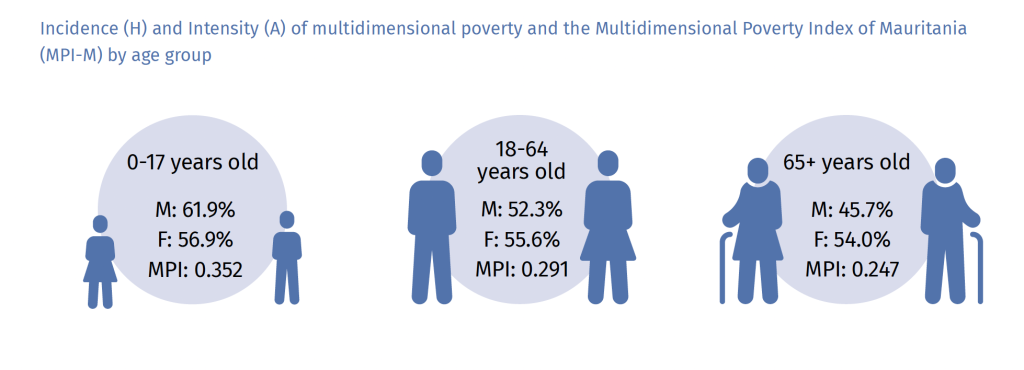
MPI-M for better planning of poverty reduction policies
A study was carried out in June 2023 by the Ministry of the Economy and Sustainable Development (MEDD) and ANSADE with technical support from ESCWA. It focuses on optimising poverty reduction policies using the MPI-M and has made it possible to prioritise effective economic and social policy guidelines to achieve poverty reduction objectives. It took into account territorial disparities in the sectors of education, health, household living conditions, and employment.
Results showed, for example, that to reduce poverty by 30% in the wilaya of Guidimagha, a region with the highest prevalence of monetary and multidimensional poverty in the country, it would be necessary to: (i) improve health insurance coverage for 39% of the poor and deprived population; (ii) ensure the completion of basic education for 42% of the poor and deprived population; (iii) promote employment for more than 30% of the poor and underemployed labour force, particularly women and youth under the age of 35.
MPI-M for evaluation of public policies
Integrating the MPI-M into the national poverty monitoring system (through the EPCV) will enable the monetary and multidimensional poverty indicators to be updated in 2025, using the EPCV 2024–2025.
This should inform the latest five-year plan of the SCAPP, which is intended to accelerate the achievement of the 2030 Agenda, and to monitor and evaluate sectoral performance in improving household living conditions.
Having up-to-date information, less than six years away from 2030, the horizon set by several national strategies (SCAPP 2016-2030) and international agendas (SDGs 2015–2030), will make it possible to:
- Identify the poor and deprived populations that should benefit from social protection programmes, taking into account regional disparities and the specific deprivations they face.
- Target economic and social policies to reduce poverty more effectively.
- Allocate resources more effectively by directing them towards the largest deprivations faced by people living in multidimensional poverty.
This article was published in Dimensions 17















